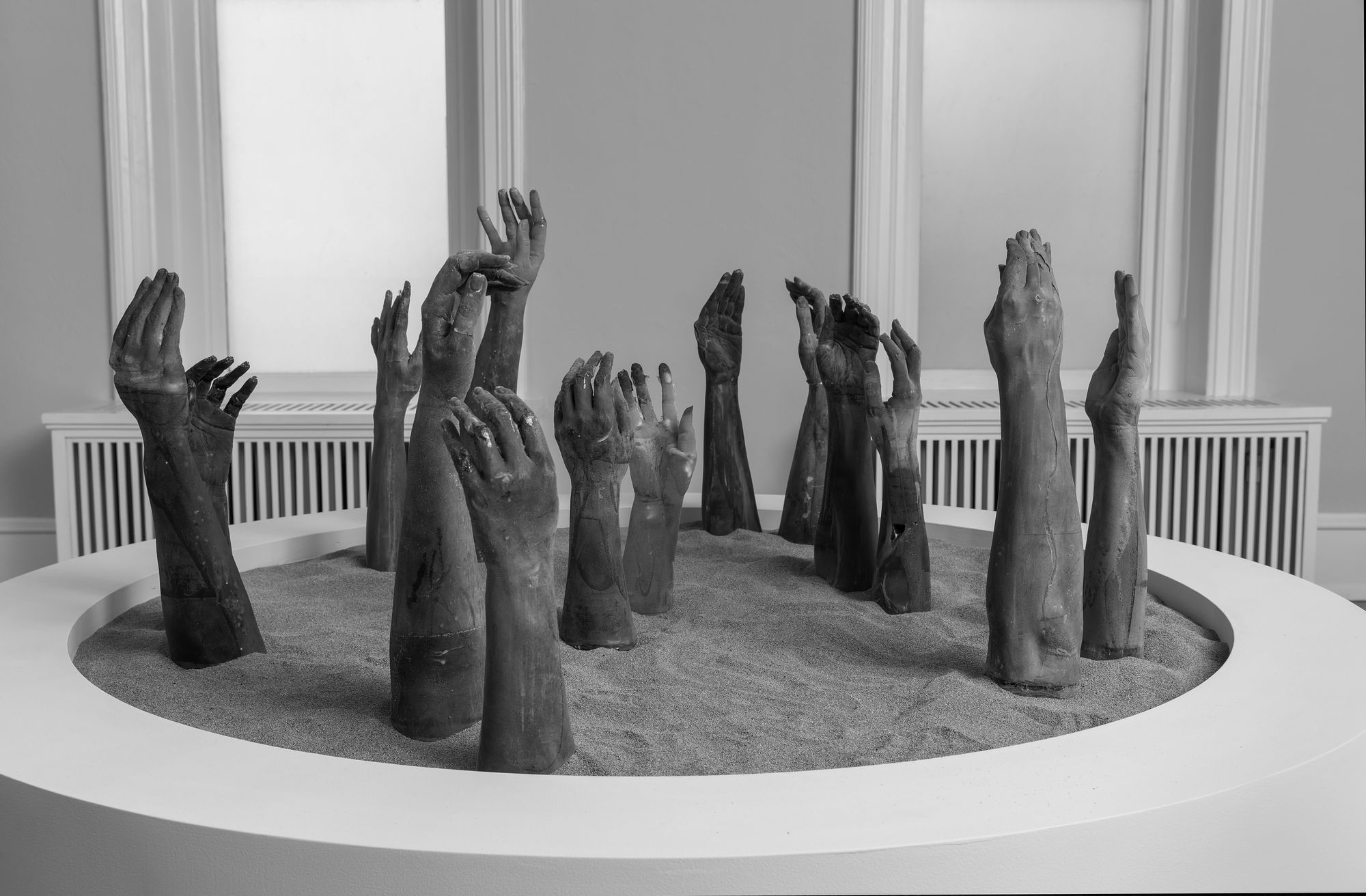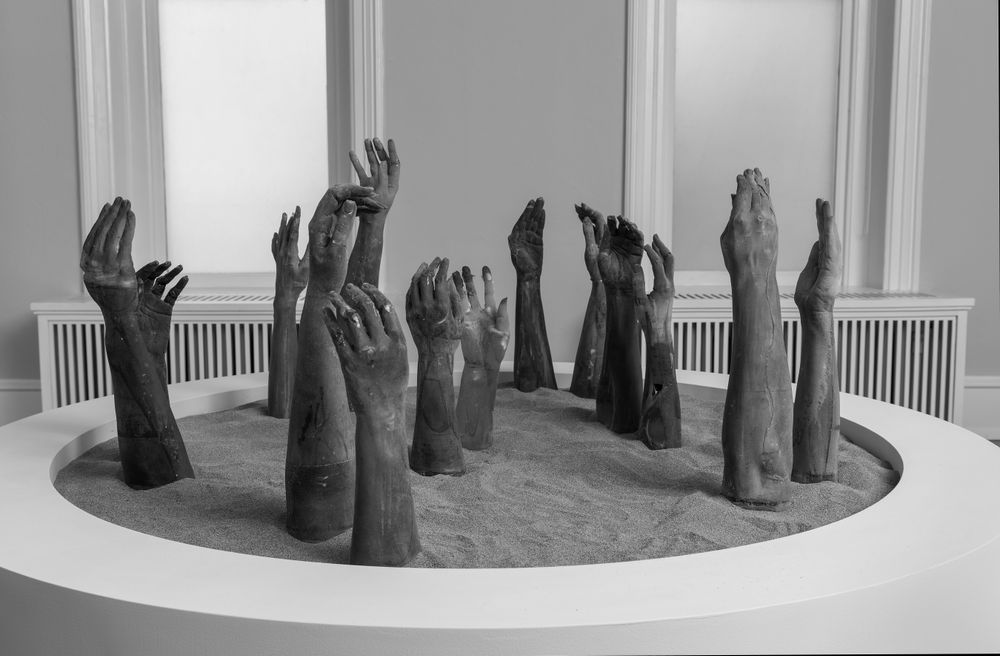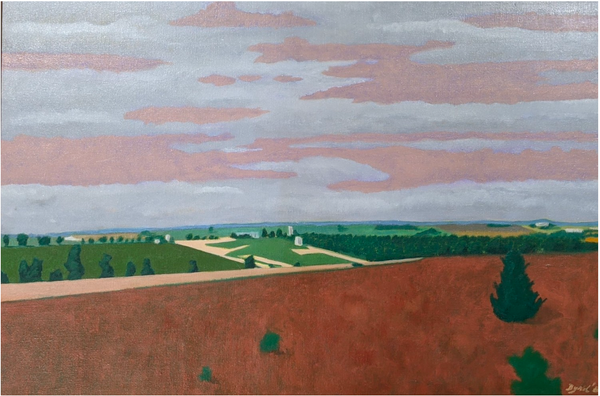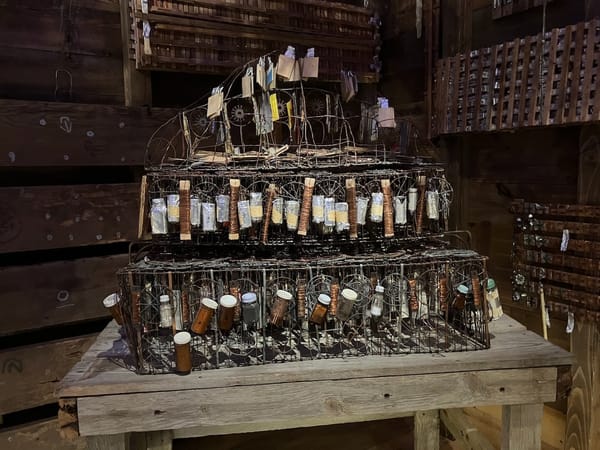Experiencing An End of World Vision
by Leovardo Aguilar
College classes are out of session for spring break and my mom is still recovering from her partial hip replacement. She asks me to exchange some library books for her, so I fling open the front door to sample the air. Not too cold, I think to myself. My green flannel with it’s imitation green Grinch pelt is enough to keep me comfortable during the walk. I don’t know when I left the house, but it was just after 12 o’clock when I’d arrive to a library that doesn’t open until 1pm on Sundays. With a sigh and a quick shudder thanks to the constant lakeside breeze, I remember the John Michael Kohler Arts Center is less than two blocks away. After checking my phone to make sure they are open, it didn’t take a second thought to head over in search of inspiration and mental relief. Once there, I was met with a cold and impersonal entrance–one made of glass, metal, brick, and flanked by an old cement library entrance.
Waiting inside are exhibits ripe with explorations in comfort, acceptance, optimism, and the reimagining of life’s coarsest moments. I didn’t know any of this then, I’m just trying to kill time. Even so, my cold cheeks crack into a smile as I pass the inner doors and look up at the steep vaulted ceiling. To my right is the gift shop. To the left is a public crafting room, complete with a mounted dragon’s head. I go straight ahead to the front desk where a familiar face greets me and causes that cold smile to continue thawing. I remember the greeter’s face and their Where the Wild Things Are tattoo peeking from the forearm but can’t put my finger on a name.
“How often do the exhibits change?” I awkwardly ask the greeter. They inform me that exhibits typically last for six months. I thank them and push forward. Like a snowbird on vacation, I’m eager to take in the sights and relish the warmth.
After passing the front desk you can choose to go left or choose to go right. Each of the building’s wings hold separate works and viewing opportunities. Thanks to the architectural layout, the two wings remain separate and force you to choose a path before revealing any secrets. Today, I follow my heart–the left wing beckons me. An arching doorway forces me into awe long enough to read the first artist’s name: Moisés Salazar Tlatenchi and their show titled A Quién le Importa. Tearing through the lines of text describing the show, my eyes need reminding to slow down. My mind wants to absorb as much new material as possible, but I have no open space. Too much mental baggage.
Once finished with the reading, I step inside the first of Tlatenchi’s three lush “rooms.” Waiting inside are multiple faceless figures with brown skin of a familiar tone- familiar to me, but unfamiliar in an artistic setting such as this. They pose comfortably, individually or in pairs. With no eyes, they had no way of gazing back and seeing my awkward sense of recognition or admiration. Reminiscent of characters from a church’s windows, my instincts told me to try and hide. The paintings were kind enough to reach out and remind me of their messages, mainly of self-acceptance and love. While the subject matter itself was within reach, I found the materials used to be most relatable.
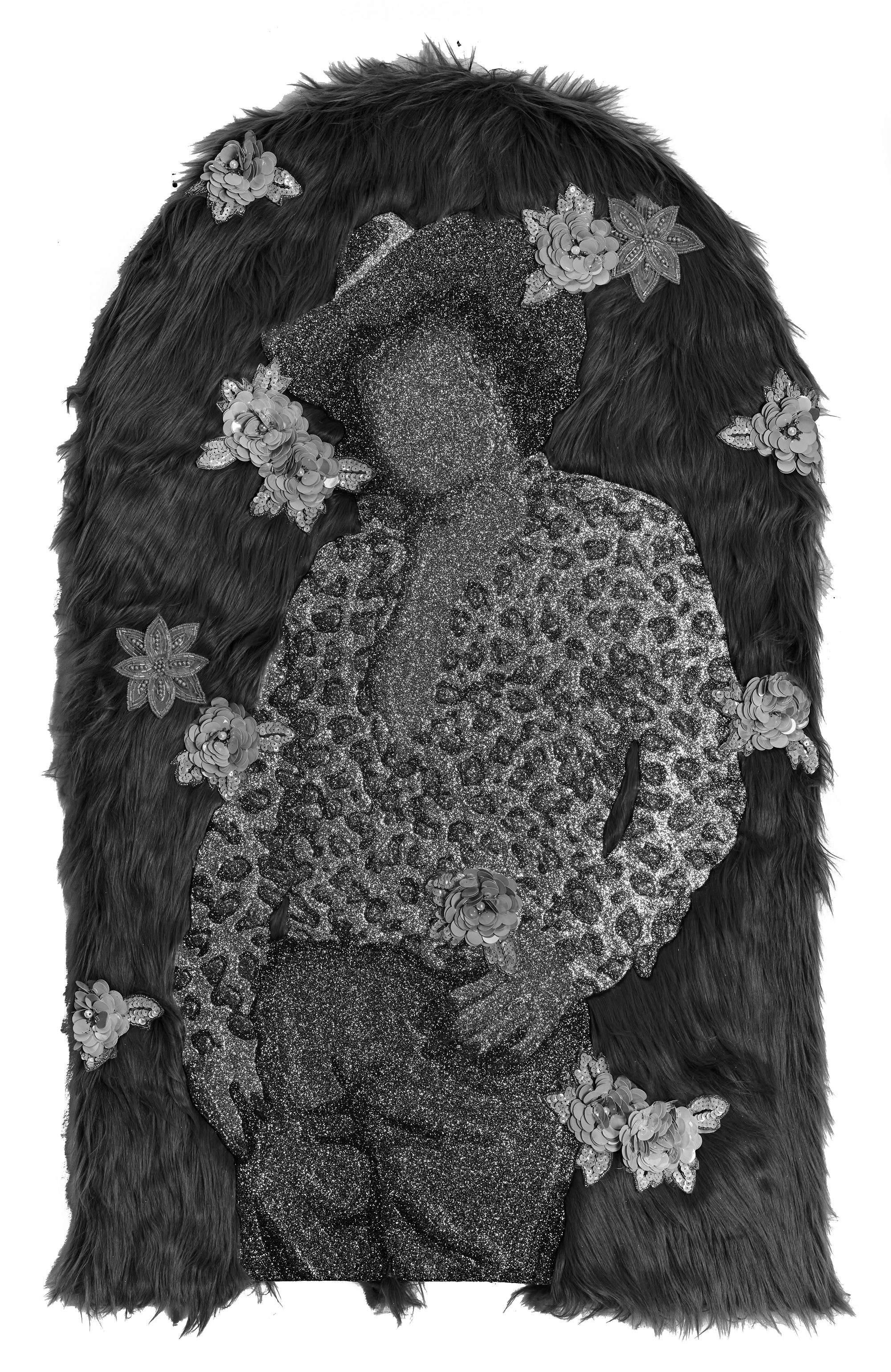
I’m not sure if nostalgia is a legitimate medium by itself, but I acknowledge the feathers, knit material, faux fur, paint, sequins, and excessive amounts of glitter as being masterfully used. As I try and fail to decipher my reaction to the pieces, I notice a peaceful juxtaposition of time, space, and love. As if the artist imagined a childhood full of understanding and acceptance that we could relive alongside the adult characters depicted in the art.
With my emotional armor now damaged, I keep moving. The series of narrow, arched hallways finally opens and hands me another forked road to face. Ahead of me is a blocked off area with a blackened carnival style curtain door. This area is apparently the source of that singular, deep, cello-like chord that I noticed while by the front desk. It pumps out ominously. Repetitively. Reliably. Complete with a sardonic heartbeat all it’s own, I later learned that Morehshin Allahyari’s piece طلعت ماه Moon-Faced awaits inside the darkened viewing area. To the left of me is the Glass Gallery, an auxiliary wing with a finnicky schedule that seems more immediately inviting. A quick glance at the small sign beside the doorway tells me all there is to know–Go this way!, complete with a leftward arrow.
Inside the Glass Gallery is Angela U. Drakeford’s In bloom at the end of the world. A curated space full of plants, bird noises, water sounds, comfortable seating and warmth enclosed by glass panes. Outside the thin veils sits a desolate world of snow and miserable evergreen trees who stare back begrudgingly. The artist’s intent of creating a comforting space was well executed. There are books to read, a table with journals waiting to be used, family photos of years past and knick- knacks expertly arranged inside glass cabinets. Like a grandmother’s house, the space looks familiar. Who’s grandmother, I can’t say. I’ve never been here- it’s too good to be true, like a fairy tale trap.
Luckily, it’s all real: the stillness, the peace, the comfort. The comfort. This isn’t just a place to sit and relax after a long day, Drakeford actively says this space “prioritizes an atmosphere that allows for processing grief of all kinds—including loss of memories, cultural traditions, and communal support.” Beyond that, this exhibit is meant to be displayed during the darkest months of the year to help those who in need.
Sitting alone on a couch too comfortable for my own good, it takes me a few minutes of absorbing the environment to accept this space. To accept _______: the loss of friends, family members, opportunities in life, that everyone grows older, just life in general. With bright light and physical warmth, the first sparks of personal recharge were finally happening. I was able to fully thank the environment fortaking me in before it gently reminded me my museum tour had a few more stops- and I still needed to exchange those library books.
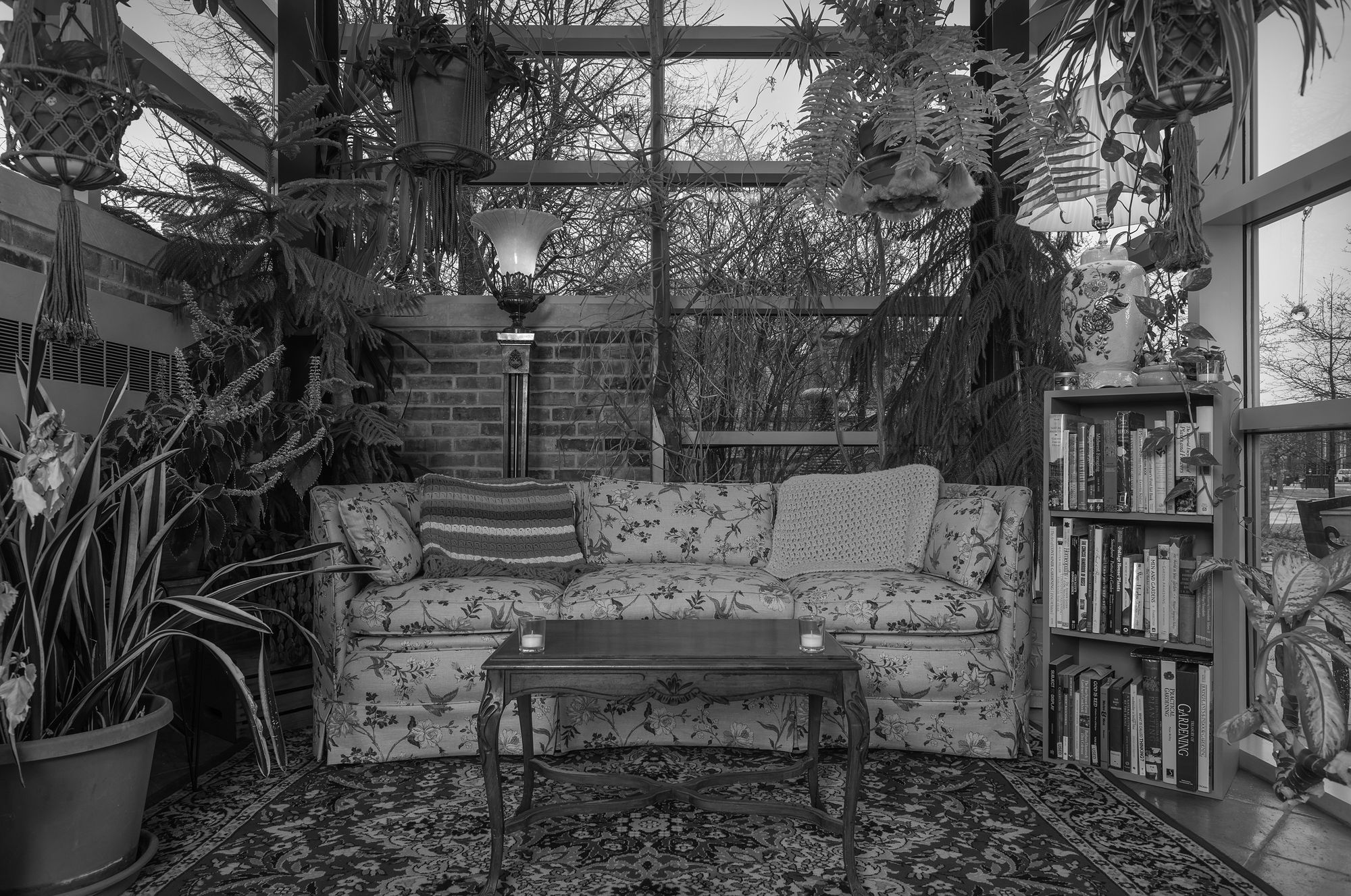
Marching forward with a new invigoration, I find Sara Zapata’s A Resilience of Things Not Seen. This installation consists of 3D shapes covered in soft fabrics and yarns holding strong in the center of the room, with a mirrored version hanging from the ceiling. Bold- if such a word is sufficient here- colored stripes reminiscent of a big top circus and daring pin stripe suit cling to every surface not covered by fabric. Half the room is alternating purple and red with the latter being a light chestnut and grey. If only one could sit and ponder life here as well.
After circling the room multiple times, it became clear that this wing of the museum had been addressed. It was time to see the less than linear right wing. This side of the building opens up more, with its headwaters meandering into tributaries that can be easily missed or ignored. The amazing Creative! Growth! exhibition is on display, an interesting surprise since I’d just learned of this non-profit arts center during a class in school. Creative! Growth! is a smorgasbord of breathtaking series and pieces made by disabled artists at the non-profit Creative Growth arts center in Oakland, CA. Artists from the center now enjoy national and international exposure.
Peeking out from the rectangular doorways ahead is a series of school children’s art from around Sheboygan County. Ranging from elementary to high school age, the pieces are a fun reminder of the potential we’re all imbued with. Here, in the local art section, the allure of a bustling café lures in guests who’ve had enough art for the day. As for myself, I know my favorite museum haunt waits ahead in an easily missed corridor. Here, in an original section of a late 1800s or early 1900s home, is a still relevant living space that accentuates whatever forms of art displayed here. Complete with wooden floors that squeal and belch when stepped on, enjoying the art means you must also appreciate the setting.
Today, the old rooms are hosting Andrea Chung’s if they put an iron circle around your neck I will bite it away. The goal is to represent a cross section of an underwater Afrofuturist utopia. With a masterful use of the color blue and an exchange of it’s negative connotations for vigorous ones, these rooms feel like a lived-in sanctuary. Statuettes are placed intentionally throughout and offered candles, crystals and similar affections which add to the feel that you’re intruding in someone’s home. It comes as a shock the fireplace isn’t still warm, or that the living herbarium hasn’t been recently plucked. Resin cast hands emerge from the wall space or stand on their own- some reaching out to show off filamentous growth, algae or moss, emerging from their skin.
Figures and paintings are sparse in these rooms, offering gaps filled with sea- green or blue hues, or antique wooden furniture and metal works. Despite this, no one is wanting. Everything is properly proportioned, and there is always a visual respite to be found by the small crystal grouping or patch of sand strewn about. The room’s feeling is ethereal, but I know too well the strength hidden by a body ofwater. In one of the farthest rooms stands a circular container filled with blue sand and a chorus of outstretched resin arms. Each one is uniquely chipped or cracked, swirled with waves of oceanic color schemes and again supporting gentle bunches of filaments. Something forces me to ask if I should help them until I realize they don’t need a savior. Instead, they need acknowledgment.
By now, the time was well after 1 pm. My mind was sloshing about as I walked towards the main halls, trying to reorganize facts and emotions and thoughts. In this moment, it became necessary to visit the restroom before leaving. I didn’t “need to go” but I needed to visit for sure. The museum actively advertises that they hold the most impressive toilets in the world- and they’re serious. Every inch of the toilet bowls, urinals, walls, any and all porcelain surfaces in any of the multiple restrooms found in the building, were once painstakingly decorated before receiving their final glaze and firing at the Kohler Co. foundry some years ago. With all the baggage I entered with, and after all the baggage I’d earmarked for disposal, one major thorn was now striking me. I couldn’t stop thinking of what designs I’d put on my custom toilet bowl.
